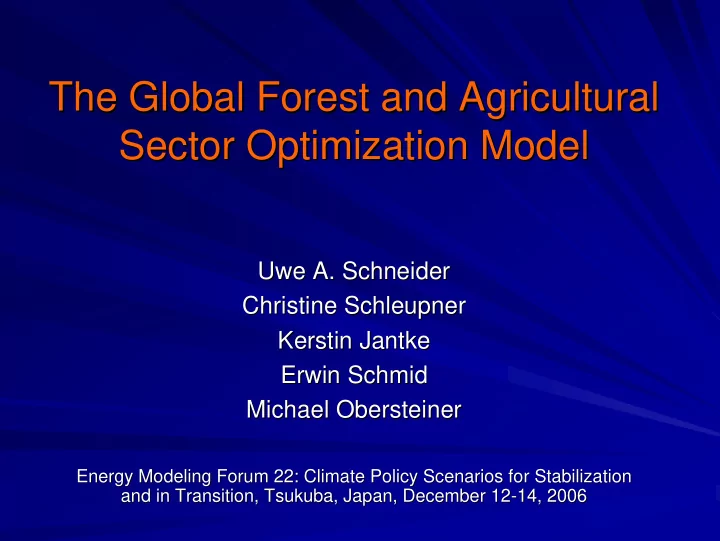

The Global Forest and Agricultural The Global Forest and Agricultural Sector Optimization Model Sector Optimization Model Uwe A. Schneider A. Schneider Uwe Christine Schleupner Schleupner Christine Kerstin Jantke Jantke Kerstin Erwin Schmid Schmid Erwin Michael Obersteiner Obersteiner Michael Energy Modeling Forum 22: Climate Policy Scenarios for Stabilization tion Energy Modeling Forum 22: Climate Policy Scenarios for Stabiliza and in Transition, Tsukuba, Japan, December 12- -14, 2006 14, 2006 and in Transition, Tsukuba, Japan, December 12
Why Global FASOM? Why Global FASOM? Global Trade Global Trade Pollution Leakage Pollution Leakage Global Externalities Global Externalities Heterogeneity Heterogeneity – Soils Soils – – Land management Land management –
Methodological Developments Methodological Developments 1. Regional Expansion (Global FASOM) Regional Expansion (Global FASOM) 1. 2. Soil State Dynamics Soil State Dynamics 2. 3. Biodiversity Biodiversity 3.
1. Regional Expansion 1. Regional Expansion Global FASOM Global FASOM
FASOM History FASOM History US (1993- -) ) US (1993 EU (2004- -) ) EU (2004 Global (2006- -) ) Global (2006
US/EU Regions US/EU Regions Limits Trade Resources Land Use Products Markets Technologies Inputs Demand Processing Environmental Supply Technologies Impacts Functions Capacities
Non- -US/EU Regions US/EU Regions Non Limits Trade Supply Resources Land Use Products Markets Technologies Inputs Demand Processing Environmental Supply Technologies Impacts Functions Capacities
Tasks Tasks US + EU FASOM + others US + EU FASOM + others Balance Regional Resolution Balance Regional Resolution Land use in non- -US / non US / non- -EU EU Land use in non – Microeconomics (Data) Microeconomics (Data) – – Environmental impacts (Simulation) Environmental impacts (Simulation) –
2. Soil State Dynamics 2. Soil State Dynamics
Why Soil State Dynamics? Why Soil State Dynamics? Vulnerability (Humus, Salt) Vulnerability (Humus, Salt) Climate Mitigation Climate Mitigation Productivity Productivity Desertification, Salinization Salinization Desertification,
Soil Carbon Determinants Soil Carbon Determinants Crop Choice Crop Choice Tillage Tillage Soil Soil Irrigation Irrigation Carbon Carbon Fertilization Fertilization Change Change Residue Mgt Residue Mgt Soil Carbon Soil Carbon
3 Cereal Straw Removal Cereal Straw Removal 2 1 Yields percentage change years 0 10 20 30 40 50 -1 -2 -3 -4 Soil Organic Carbon -5
45 40 Soil Organic Carbon (tC/ha/20cm) 35 Wheat-Lucerne 3/3 30 Wheat-Lucerne 6/3 25 20 No-till wheat-fallow 15 Tilled wheat-fallow 10 5 0 10 20 30 40 50 Time (years)
Previous Previous Curse of Dimensionality Curse of Dimensionality Use of constant emission/sequestration Use of constant emission/sequestration coefficients coefficients New Development New Development Markov chain using soil organic carbon as Markov chain using soil organic carbon as state variable (Schneider, 2007) state variable (Schneider, 2007)
Soil Carbon Transition Probabilities Soil Carbon Transition Probabilities SOC1 SOC2 SOC3 SOC4 SOC5 SOC6 SOC7 SOC8 SOC1 0.81 0.19 SOC2 1 SOC3 0.09 0.91 SOC4 0.31 0.69 SOC5 0.5 0.5 SOC6 0.74 0.26 SOC7 1 SOC8 0.04 0.96 No-till wheat-Fallow
45 40 Soil Organic Carbon (tC/ha/20cm) Wheat-Lucerne 3/3 35 30 Wheat-Lucerne 6/3 25 20 No-till wheat-fallow 15 10 Tilled wheat-fallow 5 0 10 20 30 40 50 Time (years)
Extensions Extensions Soil Carbon Types Soil Carbon Types Salt Salt
3. Biodiversity 3. Biodiversity
Previous Treatment Previous Treatment So far biodiversity is ignored in FASOM So far biodiversity is ignored in FASOM Comparable models use biodiversity scores Comparable models use biodiversity scores New Development New Development Species or habitat requirements Species or habitat requirements Habitat supply Habitat supply Currently limited to wetlands Currently limited to wetlands
Habitat Requirements Habitat Requirements Vertebrate species as surrogates for Vertebrate species as surrogates for biodiversity biodiversity – 16 amphibians 16 amphibians – 72 wetland species of – 4 reptiles 4 reptiles – European conservation concern – 9 mammals 9 mammals – – 43 birds 43 birds –
Habitat Requirements Habitat Requirements Multiple species may require the same Multiple species may require the same habitat habitat Eligible habitats must be of minimum size Eligible habitats must be of minimum size
Habitat Supply Habitat Supply Ecosystem Type Ecosystem Type – 1. Mires (Bogs, Fens) – 1. Mires (Bogs, Fens) – 2. Wet forests (Alluvial Forests, Swamp Forests) – 2. Wet forests (Alluvial Forests, Swamp Forests) – 3. Natural Grasslands – 3. Natural Grasslands – 4. Open waters (Running Waters, Standing Waters) – 4. Open waters (Running Waters, Standing Waters) Ecosystem Quality Ecosystem Quality 1. Existing, Inhabited 1. Existing, Inhabited 2. Existing, Not inhabited 2. Existing, Not inhabited 3. Potential 3. Potential
Peatland (Fens, Bogs) Marshes, Reeds, Sedges Open Waters Wetforests
Peatland (Fens, Bogs) Marshes, Reeds, Sedges Open Waters Wetforests
Existing Wetlands Potential Wetlands Open Waters
Existing Wetlands Potential Wetlands Open Waters
Conclusions Conclusions Land use (change) may play an important Land use (change) may play an important new role via climate change mitigation new role via climate change mitigation However, land use impacts are complex However, land use impacts are complex and affect multiple non- -market goods market goods and affect multiple non We should not solve today’ ’s problem by s problem by We should not solve today creating another one tomorrow creating another one tomorrow Land use under multiple environmental Land use under multiple environmental objectives may be much different than objectives may be much different than under single (climate) objectives under single (climate) objectives
Global Environmental Treaties Global Environmental Treaties Framework Convention on Climate Framework Convention on Climate Change (UNFCCC, 1992) Change (UNFCCC, 1992) Convention on Biological Diversity (CBD, Convention on Biological Diversity (CBD, 1992) 1992) Convention to Combat Desertification Convention to Combat Desertification (UNCCD, 1996) (UNCCD, 1996)
References References Schneider, U. A. (2007). Soil organic carbon Soil organic carbon Schneider, U. A. (2007). changes in dynamic land use decision changes in dynamic land use decision models. . Agriculture, Ecosystems and Agriculture, Ecosystems and models . In print. Environment . In print. Environment
Recommend
More recommend